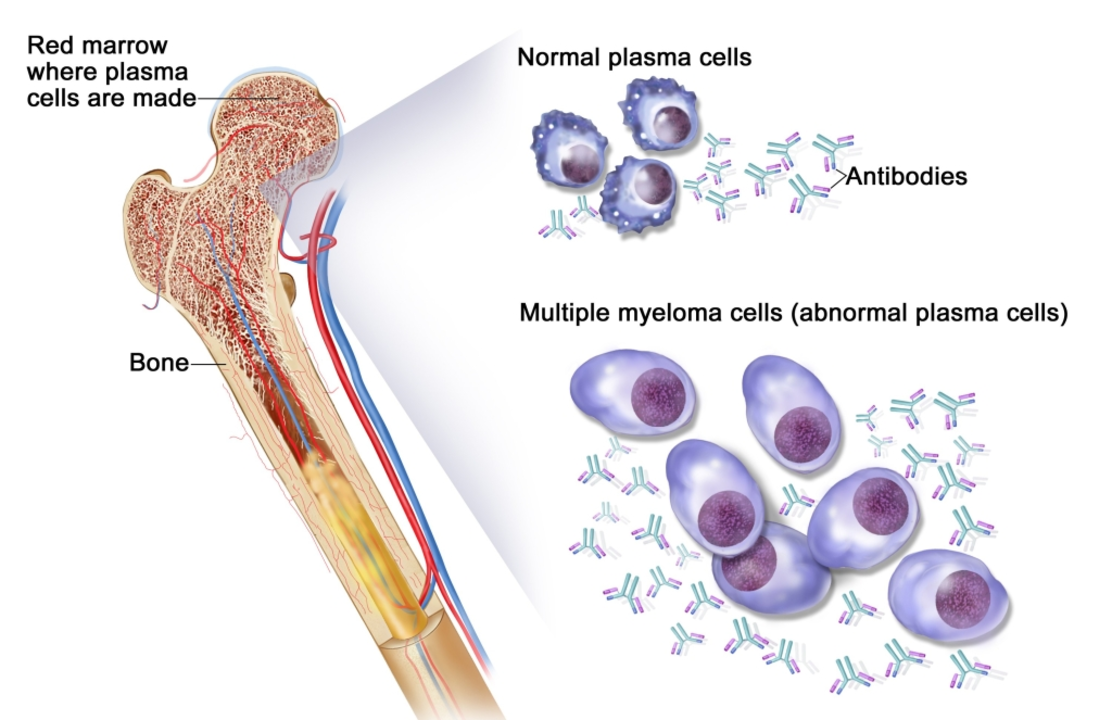What is Multiple Myeloma?
As someone who has been researching and writing about various health conditions, I have come across many people who are not aware of multiple myeloma. It's a type of cancer that forms in the plasma cells, which are responsible for producing antibodies that help our immune system fight infections. In multiple myeloma, these plasma cells multiply uncontrollably, leading to various complications. So, let's understand what multiple myeloma is and how it affects our body.
Multiple myeloma is a cancer of the bone marrow, which is the soft, spongy tissue found inside our bones. This is where our body produces new blood cells, including plasma cells. When someone has multiple myeloma, the cancerous plasma cells begin to take up space in the bone marrow, preventing the production of healthy blood cells. This can lead to a weakened immune system, anemia, and other complications. In this comprehensive guide, we will explore multiple myeloma in detail and discuss its symptoms, causes, and treatment options.
Symptoms and Early Signs of Multiple Myeloma
One of the reasons that multiple myeloma often goes undiagnosed in its early stages is that the symptoms can be very subtle or even nonexistent. However, as the disease progresses, it can cause a variety of symptoms that can be quite debilitating. Some of the most common symptoms of multiple myeloma include:
1. Bone pain, especially in the back, hips, or ribs
2. Frequent infections due to a weakened immune system
3. Fatigue and weakness due to anemia
4. High levels of calcium in the blood, which can lead to kidney problems and constipation
5. Nerve damage, causing numbness, tingling, or weakness in the hands and feet
It's crucial to be aware of these symptoms and consult a doctor if you experience any of them. Early diagnosis and treatment can significantly improve the prognosis for people with multiple myeloma.
Diagnosis and Staging of Multiple Myeloma
Diagnosing multiple myeloma can be a complicated process, as there is no single test that can definitively confirm the presence of the disease. Instead, doctors typically use a combination of tests and procedures to rule out other conditions and determine if a person has multiple myeloma. Some of the tests that may be performed include blood tests, urine tests, bone marrow biopsy, and imaging studies such as X-rays, MRIs, or PET scans.
Once a diagnosis has been made, the doctor will determine the stage of the disease. Staging is important because it helps guide treatment decisions and provides information about a person's prognosis. Multiple myeloma is typically staged using the International Staging System (ISS), which takes into account the levels of certain proteins in the blood. The ISS has three stages, with stage I being the least advanced and stage III being the most advanced.
Treatment Options for Multiple Myeloma
As with many types of cancer, the treatment options for multiple myeloma can vary depending on the stage of the disease and the individual's overall health. Some of the most common treatment options include:
1. Chemotherapy: This is often the first line of treatment for multiple myeloma. Chemotherapy drugs work by killing rapidly dividing cells, including cancer cells. However, they can also affect healthy cells, leading to side effects such as hair loss, nausea, and fatigue.
2. Targeted therapy: These drugs specifically target the cancer cells, often with fewer side effects than traditional chemotherapy. Examples of targeted therapy drugs for multiple myeloma include proteasome inhibitors and immunomodulatory drugs.
3. Stem cell transplantation: In some cases, a stem cell transplant may be recommended to replace the damaged bone marrow with healthy stem cells. This can help the body produce new, healthy blood cells and improve the immune system's ability to fight the cancer.
4. Radiation therapy: This treatment uses high-energy radiation to kill cancer cells and shrink tumors. It may be used in combination with other treatments or to help control pain caused by bone damage.
5. Supportive care: This includes treatments to help manage the symptoms and side effects of multiple myeloma, such as pain medications, blood transfusions, and antibiotics for infections.
It's important to remember that every person's experience with multiple myeloma is different, and the best course of treatment will depend on individual factors. Always consult with your healthcare team to determine the most appropriate treatment plan for your specific situation.
Living with Multiple Myeloma
Receiving a diagnosis of multiple myeloma can be overwhelming and life-changing. However, many people with this disease can still lead fulfilling lives with the help of proper treatment and support. Here are some tips for living with multiple myeloma:
1. Educate yourself: Learn as much as you can about multiple myeloma, its treatment options, and potential side effects. This can help you make informed decisions about your care and feel more in control of your health.
2. Communicate with your healthcare team: Keep an open line of communication with your doctors, nurses, and other healthcare providers. Don't be afraid to ask questions or voice your concerns.
3. Seek support: Reach out to friends, family, and support groups for emotional support and practical assistance. Connecting with others who are going through similar experiences can be incredibly helpful.
4. Take care of your physical health: Eat a balanced diet, get regular exercise, and maintain a healthy weight. This can help improve your overall well-being and may even help your body better tolerate treatment.
5. Prioritize mental health: Consider seeking counseling or attending support group meetings to help cope with the emotional challenges of living with multiple myeloma.
Remember, you're not alone in your journey with multiple myeloma. With the right information, treatment, and support, you can continue to live a meaningful and fulfilling life.




Khanyisa Mhlongo
May 11, 2023 at 16:59This is such a vital resource! I’ve seen friends go through this and the lack of awareness is heartbreaking. The way you broke down symptoms and treatments? Pure gold. Seriously, this should be linked everywhere. <3
Nancy Lowry
May 11, 2023 at 17:07Honestly? Most people don’t even know plasma cells exist. You’d think basic biology was taught in high school anymore. This guide is better than half the oncology websites I’ve seen. Pathetic that we need laypeople to explain this.
Manvika Gupta
May 12, 2023 at 06:51i just lost my aunt to this last year. your post made me cry but in a good way? like… she never got this kind of info. it was all scary doctor jargon. thank you for making it human.
Hobert Finn Bodfish
May 12, 2023 at 19:49If you’re not getting a bone marrow biopsy by 45 with unexplained back pain, you’re doing it wrong. 😤 This post is basic but necessary. Stop googling ‘back pain causes’ and start googling ‘multiple myeloma symptoms’.
Andrea Galetto
May 12, 2023 at 23:21This is what happens when you let non-medical influencers write about cancer. It’s oversimplified. Proteasome inhibitors? You barely mentioned carfilzomib. Pathetic.
Daniel Rogers
May 13, 2023 at 12:41You’re doing God’s work here 🙏 I know someone in remission after stem cell transplant - she’s hiking mountains now. Hope isn’t just a word. It’s a treatment plan. Keep sharing this.
Chris Remo
May 13, 2023 at 22:48I read this on my lunch break. My mom’s been in treatment for 3 years. You nailed it. Especially the part about mental health. Nobody talks about how lonely it gets. Thanks.
Michael Herr
May 14, 2023 at 01:30This is exactly what the public needs. No fluff. No fearmongering. Just facts. If you're reading this and know someone with bone pain and fatigue, send them this link. Now.
Crystal Magnant
May 14, 2023 at 09:43I cried reading this. My sister was diagnosed last month. I printed this out and gave it to her oncologist. He said it was the best summary he’d seen. 🤍
Danie Joy
May 15, 2023 at 04:01Wait… are you sure this isn’t a government mind control experiment? I mean… why is this not on the nightly news? Why are they hiding this? The pharmaceutical companies are definitely suppressing the real cure. I saw a video on TikTok…
Katherine Stapp
May 15, 2023 at 05:08This is why America’s healthcare system is failing. People are dying because they don’t know the signs. We need mandatory screenings. Like… right now. #MyelomaMatters
Frank De Silva
May 16, 2023 at 00:18Interesting. But where’s the data on long-term survival rates post-transplant? You mention treatments but not outcomes. This feels… performative. Like a PSA someone wrote for their LinkedIn.
KJ Miller
May 16, 2023 at 00:40I’ve been a caregiver for 5 years. This post? It’s the first one that didn’t make me feel like a burden. You honored the quiet strength of patients. Thank you.
Claire Battista
May 16, 2023 at 20:37I shared this with my book club. We’re all over 50. Nobody knew what plasma cells were. Now we do. And we’re talking about it. That’s huge.
Erin DeGroot
May 17, 2023 at 08:05The emotional weight of this guide is not lost on me. The quiet dignity with which you described living with the disease - it’s rare. I’m forwarding this to my entire medical team.
Stephanie Bryant
May 17, 2023 at 16:32I’m a nurse and this is the best patient handout I’ve seen. I’m printing 20 copies. Typo on page 3 - ‘proteosome’ should be ‘proteasome’ - but the heart is 100% there 💕
Drashti patel
May 18, 2023 at 03:31In India, many think cancer is a punishment. This post could change that. Thank you for writing with such clarity. I’ll translate it for my community.
Kaitlin Crockett
May 18, 2023 at 17:09Is there a link to the latest clinical trial data?
Chloe McDonald
May 18, 2023 at 22:08I just sent this to my dad. He’s been ignoring his back pain for months. He’s calling his doctor tomorrow. You saved him. Seriously.